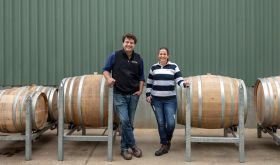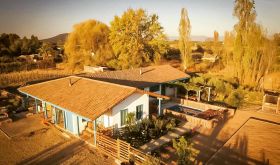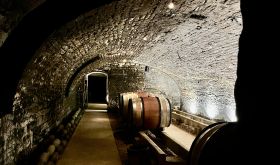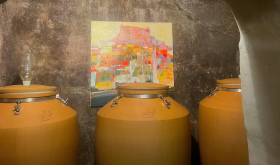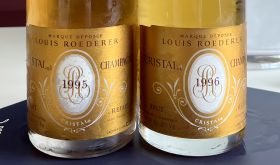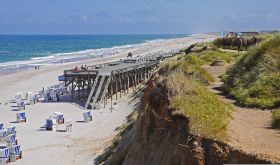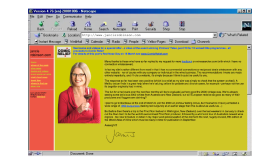I came across the Qvinterra Riesling trocken 2023 at a recent Howard Ripley tasting in London and gave it the relatively rare accolade of VGV, very good value. I tasted the 2022 vintage last week since that’s the current vintage on the US market (the 2023 soon to follow) and it was equally impressive and refreshingly delicious.
The Kühling-Gillot estate, today owned and run by Carolin Spanier-Gillot and her husband Hans Oliver (known as H O) Spanier, was established more than two centuries ago in Bodenheim south-east of Mainz and has been known by various names during that time.
In 2006, Carolin Gillot married Spanier, founder in 1991 of Battenfeld Spanier, creating an alliance of two of Rheinhessen’s most well-known estates. While the two properties have retained their separate identities, Spanier has been making the Kühling-Gillot wines since 2006 in the deep cellars of the Battenfeld Spanier winery in Hohen-Sülzen, west of Worms (see this World Atlas of Wine map of the Rheinhessen region).
Kühling-Gillot’s vineyards comprise 25 ha (62 acres) of vines in the villages of Oppenheim (pictured at the top of this article), Nierstein, Nackenheim, Bodenheim and Laubenheim, including holdings on the Rheinfront, between Oppenheim and Nackenheim, home to the famous Roter Hang, the red-slate vineyards that slope steeply down to the Rhine.
More than half their vineyards are classified as Erste Lage or Grosse Lage by the VDP, the private winegrowers’ association of which both estates are a member. The Battenfeld Spanier vines, planted mainly on limestone sites, are further south around the villages of Hohen-Sülzen, Nieder-Flörsheim and Molsheim.
In an email to me last week, Spanier-Gillot, summarising how the two estates run in parallel, wrote, ‘If you want to explain terroir, you’ve come to the right place: the same winemakers, the same vinification … and such different wines from Kühling-Gillot and Battenfeld Spanier, only because of the different terroirs.’
The vineyards on both estates are certified organic, and biodynamic practices are followed but without certification. The grapes for Qvinterra come from vineyards in five villages with five different soil types – hence Qvinterra – predominantly from the Sackträger vineyard in Oppenheim (with underlying limestone and calcareous gravel) plus some fruit from the red-slate sites of the Roter Hang.
The interplay of the vineyards and the winemaking has given the Qvinterra Riesling trocken 2023 a lightly smoky aspect to its rich, citrus-led aromas and flavours, all wrapped up in a creamy roundness with just 12% alcohol. There’s also a slight but attractive quality that I can only describe as herbal-fumy (much nicer than it sounds), typical of Riesling fermented with ambient yeasts rather than inoculated with cultured yeasts. The richness is perfectly balanced by the freshness and vitality. (Total acidity is 7 g/l and residual sugar an imperceptible 3 g/l.)
The Qvinterra Riesling trocken 2022 comes from a drier vintage than the 2023 but, as Spanier-Gillot explained, they have been practising dry farming since 2005, ‘for example with straw covering our vineyards to protect the vines from evaporation and erosion’, so the vines are better able to cope with dry years.
The 2022 has all the intensity, freshness and personality of the 2023 as well as the first signs of evolution, developing in bottle in a way that only Riesling can, with a slightly more intense herbal-fumy note plus a touch of spice and an impression of lime and cedarwood. It fills the mouth with broad but crisp and layered citrus flavours even with the same modest alcohol as the 2022.
The two vintages were made in exactly the same way: hand-harvested, whole-bunch pressing (which is gentler than destemming and crushing the grapes before pressing), fermentation with ambient yeasts, half in stainless-steel tanks and half in large wooden casks (containing 2,400 litres, known as a Doppelstück in German). The wines stay in these vessels on the lees until bottling in spring the year after harvest, which contributes to the wines’ slightly chewy texture and overall roundness and sense of generosity. (Total acidity is slightly higher in 2022 at 7.5 g/l and the residual sugar marginally lower at 2.5 g/l.)
As impressive as the quality is the price of Qvinterra, particularly for a wine you can enjoy now or keep for a good five years if you want the full experience of mature Riesling flavours.
According to Spanier-Gillot in an interview with the VDP, Qvinterra is the wine she would choose to introduce wine lovers to her wines. (They make both a dry and an off-dry version.) Unlike some so-called ‘estate wines’ (Gutsweine in German), this has terrific concentration of flavour: depth, freshness and a lingering aftertaste. It’s also smartly packaged in a traditional tall bottle but sealed with an efficient and less traditional screwcap.
The 2022 is imported into the US by The German Wine Collection (the 2023 will follow soon) and the 2023 into the UK by Howard Ripley and Justerini & Brooks. It is available directly from Howard Ripley by the single bottle (£14.58) or per case of 6 (£87.48).
One or other vintage is available in many other parts of the world, including Germany, Italy, Spain, Switzerland, Denmark, Australia and Czechia.
If you're a member, find many more recommended wines from Kühling-Gillot as well as from Battenfeld Spanier in our tasting notes database. If you're not yet, sign up now!









